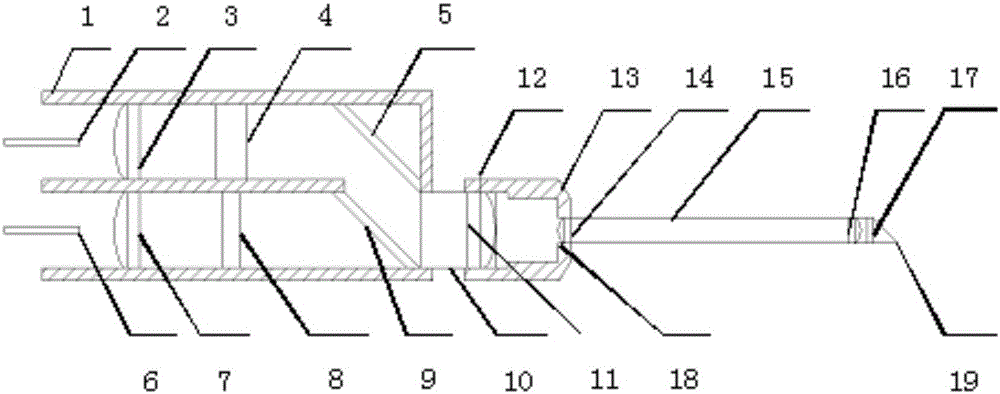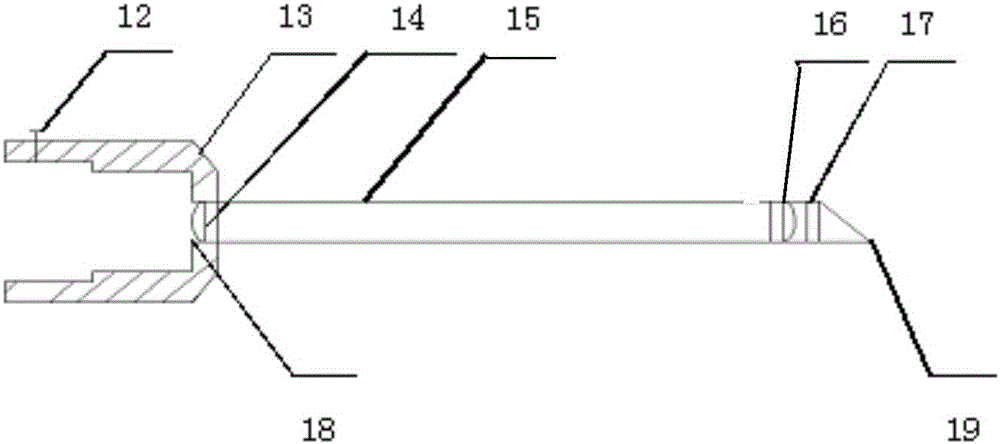Raman probe for in-vivo and in-situ puncture diagnosis
A Raman probe and puncture needle technology, which is applied in the directions of using spectrum diagnosis, diagnosis, Raman scattering, etc., to achieve the effects of reducing damage, convenient disassembly, and easy disinfection
- Summary
- Abstract
- Description
- Claims
- Application Information
AI Technical Summary
Problems solved by technology
Method used
Image
Examples
Embodiment 1
[0053] Example 1. Raman probes for in situ puncture detection in vivo
[0054] Such as figure 1 , figure 2 and Figure 7 As shown, the Raman probe used for in-situ puncture detection in the body of the present invention includes a Raman probe (the model is EN60825-1, and the manufacturer is Changchun New Industry Photoelectric Technology Co., Ltd.), and the Raman probe extension end 10 A plano-convex lens 11 with a convex surface facing the near-outer end is provided inside, and a joint 13 and a puncture needle 15 are also included;
[0055] The joint 13 is a hollow pipe sleeve with two ends straight through;
[0056] The puncture needle 15 is a hollow tube straight through at both ends, and one end is needle-shaped, which is a needle point 19;
[0057] A thread a is provided on the inner wall of the first port of the joint 13, and a thread b is provided on the outer wall of the Raman probe extension end 10, the thread a matches the thread b, and the joint 13 and the Rama...
Embodiment 2
[0080] Embodiment 2, detect biological tissue
[0081] Use the Raman probe for in situ puncture detection in the body of Example 1 to detect pork samples—fat meat and lean meat respectively, and obtain the Raman spectrogram results as follows Figure 5 and Figure 6 shown.
[0082] The results show that: the Raman signal obtained by the Raman probe used for in situ puncture detection in Example 1 is strong enough, and it can be found that the Raman signal intensity and translation width of the two samples are different on a specific Raman translation .
[0083] The above results show that the Raman probe used in Example 1 for in situ puncture detection in vivo has high sensitivity and reliability.
PUM
| Property | Measurement | Unit |
|---|---|---|
| length | aaaaa | aaaaa |
| angle | aaaaa | aaaaa |
| thickness | aaaaa | aaaaa |
Abstract
Description
Claims
Application Information
 Login to View More
Login to View More - R&D
- Intellectual Property
- Life Sciences
- Materials
- Tech Scout
- Unparalleled Data Quality
- Higher Quality Content
- 60% Fewer Hallucinations
Browse by: Latest US Patents, China's latest patents, Technical Efficacy Thesaurus, Application Domain, Technology Topic, Popular Technical Reports.
© 2025 PatSnap. All rights reserved.Legal|Privacy policy|Modern Slavery Act Transparency Statement|Sitemap|About US| Contact US: help@patsnap.com



